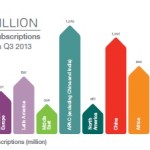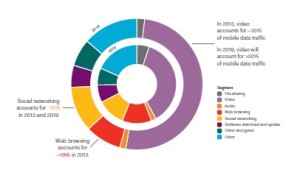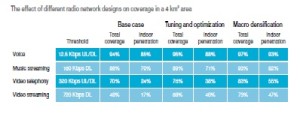 There are 4.5 billion mobile subscribers with in total 6.6 billion total mobile connections across globe at this moment. Last quarter (Q3 2013), 113 million new mobile connections added to the tally, with year-on-year growth of 7{af589cdba9d77786c8c861317dbad60bba1e2ebbf56e2ffab874a1b59fde9ce3}.
There are 4.5 billion mobile subscribers with in total 6.6 billion total mobile connections across globe at this moment. Last quarter (Q3 2013), 113 million new mobile connections added to the tally, with year-on-year growth of 7{af589cdba9d77786c8c861317dbad60bba1e2ebbf56e2ffab874a1b59fde9ce3}.
These are some of the interesting facts released in latest Ericsson Mobility Report published. While India accounts to 742 million mobile connections or 11{af589cdba9d77786c8c861317dbad60bba1e2ebbf56e2ffab874a1b59fde9ce3} of total global mobile connections (as on Q3 2013), China is leading the numbers with 1200 million mobile connection, which accounts to 18{af589cdba9d77786c8c861317dbad60bba1e2ebbf56e2ffab874a1b59fde9ce3} of total global subscriptions.
With no surprise, mobile broadband is the hottest area of growth, accounting 40{af589cdba9d77786c8c861317dbad60bba1e2ebbf56e2ffab874a1b59fde9ce3} year-on-year growth with total 2 billion broadband connections globally (Year end 2013). Among mobile broadband technologies, LTE/4G is growing fastest with 25 million additions quarter-on-quarter, while HSPA/3G is having highest net addition of 80 million.
The report predicts that there will be more than 9.3 billion mobile connections on planet by 2019, whereas mobile broadband connections will grow 4X to reach 8 billion during same period. Interestingly GSM/EDGE technologies would either move to HSPA/WCDMA over the years or to LTE and would constitute to only fraction of total mobile connections. On the other hand LTE aka 4G would become pervasive technology by 2019 accounting to 2.6 billion mobile connections or 27{af589cdba9d77786c8c861317dbad60bba1e2ebbf56e2ffab874a1b59fde9ce3} of total mobile user base by 2019.
With 10X growth in data traffic between 2013-19 total data traffic generated from mobile phones would surpass traffic generated in total from PCs, tablets, or even routers by end of 2013. Among data traffic, Video accounted to 35{af589cdba9d77786c8c861317dbad60bba1e2ebbf56e2ffab874a1b59fde9ce3} of total data traffic in 2013, which would lead the show to 50{af589cdba9d77786c8c861317dbad60bba1e2ebbf56e2ffab874a1b59fde9ce3} of total data traffic generated till 2019, while Social networking and Web browsing would only account to 10{af589cdba9d77786c8c861317dbad60bba1e2ebbf56e2ffab874a1b59fde9ce3} traffic, each.
Apart from all facts & figures, the report also highlights some deep aspects of mobile communication, one of them is Coverage-Capacity paradox (Indoor Vs Outdoor).
 If report numbers are to be believed, then over a 4 sq km area and 11 macro (3 sectors) sites would ensure 94{af589cdba9d77786c8c861317dbad60bba1e2ebbf56e2ffab874a1b59fde9ce3} of coverage for voice users in Outdoors and 85{af589cdba9d77786c8c861317dbad60bba1e2ebbf56e2ffab874a1b59fde9ce3} in Indoor case. But the same network is sufficient to provide only 48{af589cdba9d77786c8c861317dbad60bba1e2ebbf56e2ffab874a1b59fde9ce3} of coverage for video application. Reason- throughput required for video streaming (720kbps) for Outdoor case is 60 time of voice application (12.5 kbps). In fact same network is totally insufficient, if users are going to stream videos sitting indoors. Only 17{af589cdba9d77786c8c861317dbad60bba1e2ebbf56e2ffab874a1b59fde9ce3} of area would be covered satisfactorily for Indoor streaming against 48{af589cdba9d77786c8c861317dbad60bba1e2ebbf56e2ffab874a1b59fde9ce3} for Outdoor Video streaming. The situation remains same even after optimization and doubling of outdoor sites.
If report numbers are to be believed, then over a 4 sq km area and 11 macro (3 sectors) sites would ensure 94{af589cdba9d77786c8c861317dbad60bba1e2ebbf56e2ffab874a1b59fde9ce3} of coverage for voice users in Outdoors and 85{af589cdba9d77786c8c861317dbad60bba1e2ebbf56e2ffab874a1b59fde9ce3} in Indoor case. But the same network is sufficient to provide only 48{af589cdba9d77786c8c861317dbad60bba1e2ebbf56e2ffab874a1b59fde9ce3} of coverage for video application. Reason- throughput required for video streaming (720kbps) for Outdoor case is 60 time of voice application (12.5 kbps). In fact same network is totally insufficient, if users are going to stream videos sitting indoors. Only 17{af589cdba9d77786c8c861317dbad60bba1e2ebbf56e2ffab874a1b59fde9ce3} of area would be covered satisfactorily for Indoor streaming against 48{af589cdba9d77786c8c861317dbad60bba1e2ebbf56e2ffab874a1b59fde9ce3} for Outdoor Video streaming. The situation remains same even after optimization and doubling of outdoor sites.
Where is Industry moving then? Towards Indoor Small Cells or Small Base Stations, which will be installed at homes, offices or areas where maximum coverage/throughput is required i.e. near to users. Expanding outdoor sites, the solution adopted, is not going to help any further. Moving Indoor is the call, if Operators want to support more & more users for data applications.
There are other interesting facts on application ecosystem & some regional numbers to churn. Readers are encouraged to download the report for more details.




